
Claudio Coello was a Spanish Baroque painter. Coello is considered the last great Spanish painter of the 17th century.

Pellegrino Tibaldi, also known as Pellegrino di Tibaldo de Pellegrini, was an Italian mannerist architect, sculptor, and mural painter.
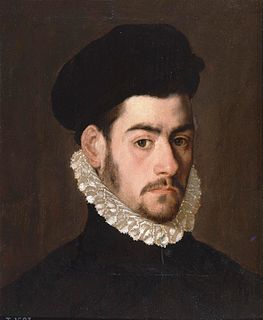
Alonso Sánchez Coello was a Iberian portrait painter of the Spanish and Portuguese Renaissance. He is mainly known for his portrait paintings executed in a style, which combines the objectivity of the Flemish tradition with the sensuality of Venetian painting. He was court painter to Philip II.
Giovanni Battista Castello was an Italian historical painter.

PhilipGalle was a Dutch publisher, best known for publishing old master prints, which he also produced as designer and engraver. He is especially known for his reproductive engravings of paintings.

Juan Pantoja de La Cruz was a Spanish painter, one of the best representatives of the Spanish school of court painters. He worked for Philip II and Philip III. The Museo del Prado contains examples of his severe portraiture style.

Eugenio Caxés was a Spanish painter of the Baroque period.
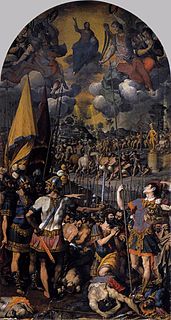
Romulo Cincinato or Cincinnato was an Italian painter of the Renaissance period, active in Spain after 1567. His two sons, Diego and Francisco Romulo were painters in Spain.

José Leonardo, known also as Jusepe Leonardo, was a Spanish painter of the Baroque period, active during his maturity in the royal court in Madrid.
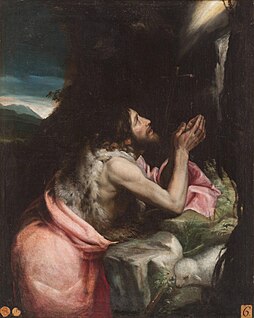
Francisco López was a Spanish painter and engraver. He was a pupil of Bartolommeo Carducci, whom he assisted in 1595 in painting for the church of San Felipe el Real at Madrid, destroyed by fire in 1718. He was appointed painter in ordinary to King Philip III of Spain. In 1603, he painted a series of paintings representing the victories of Charles V in the King’s dressing-room at the Pardo Palace. He also etched the third, sixth, and seventh plates for Vincenzo Carducci's Dialogues on Painting. He also painted Saint John the Baptist which is now at the Real Academia de Bellas Artes de San Fernando.

Francisco Rizi de Guevara (1608–1685) was a Spanish painter born in Madrid.
Diego Polo the Elder (1560–1600) was a Spanish painter of the Renaissance period. He was born in Burgos, but studied at Madrid, under Patricio Caxes, and practiced history. There are some of his works in el Escorial, and in the palace at Madrid, in which city he died. He painted a series of imagined portraits of the Visigothic kings and a St. Jerome chastised by an Angel for taking too much pleasure in reading Cicero, and a Penitent Magdalene.
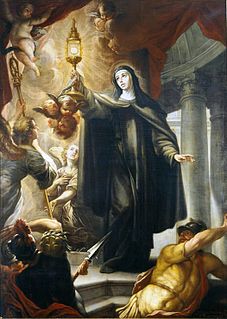
Isidoro Arredondo (1655-1702), an eminent Spanish painter, was born at Colmenar de Oreja, in 1653. He was first a scholar of José García Hidalgo, but he afterwards studied under Francisco Rizi. He painted history with much success, and on the death of Rizi, in 1685, he was appointed painter to Charles II of Spain. One of his principal works was a large picture of the 'Incarnation,' which Palomino mentions as a very grand composition along with Santa Clara (1693) and Santa Gertrudis. He painted much in oil and fresco in the churches and palaces, and the ' 'Legend of Cupid and Psyche,' in the royal palace, is considered one of his best works. He died at Madrid in 1702.

Juan de la Corte, a Spanish painter, was born at Madrid in 1597. He was instructed by Velazquez, and painted portraits and history, but chiefly excelled in battle-pieces and perspective views. He also painted small pictures of subjects from sacred history. He was painter to Philip III, and was continued in that situation by his successor, Philip IV. There are several of his pictures in the palace of Buen Retiro. He died at Madrid in 1660.
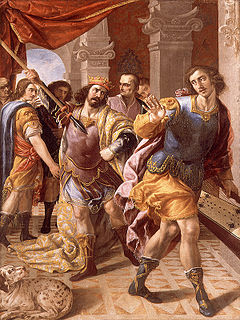
Francisco Fernández, who was born at Madrid in 1606, and brought up in the school of Vincenzo Carducho, was one of the most ingenious artists of his time, and his talent gained great reputation for him at an early age. He was employed by Philip IV in the palaces at Madrid, and in the convent of La Victoria are pictures by him of the Death of St. Francis of Paola, and St. Joachim and St. Anne. He also etched five spirited plates of allegories for Carducho's Dialogos de la Pintura, 1633. He was killed in a quarrel by Francisco de Baras in 1646.

Luis Fernández, a Spanish historical painter, both in oil and in fresco, born at Madrid in 1594, was a pupil of Eugenio Caxes. There are by him in the cross-walk of the convent of La Merced Calzada scenes from the life of St. Ramon, painted in 1625, and in Santa Cruz were several frescoes and oil paintings, which perished, however, by fire in the 17th century. His works, executed in the style of his master, are distinguished for correctness of design and beauty of colouring. He died at Madrid in 1654.

José García Hidalgo was a Spanish painter, who wrote notes of his life, but omitted to state where and when he was born. Later research showed that he was born in Villena in 1646. He was named by the artists of the day El Castellano. He studied in the city of Murcia, under Mateo Gilarte and Nicolás de Villacis. After passing some years under those masters he went to Italy, and at Rome became a scholar of Giacinto Brandi, under whose tuition he made considerable progress. Pietro da Cortona, Salvator Rosa, and Carlo Maratti assisted him with their counsels; but the climate of Italy proving detrimental to his health, he returned to Spain, where he attached himself to Carreño, and, though far advanced in the art, worked as a young pupil. In 1674 he went to Madrid, and was employed by Charles II in a series of twenty-four pictures on the life of St. Augustine, for the cloisters of San Felipe el Real, which occupied him, with other commissions from the king, till 1711. He was also much employed by Philip V, who made him his principal painter in 1703, and shortly after a chevalier of the order of St. Michael. In the latter part of his life he retired to the convent of San Felipe, and died there probably in 1719. He published Principios para estudiar la nobilissima arte de la Pintura, 1691, and several other works on anatomy and painting for the benefit of students. His productions are at Madrid, Valencia, Sigüenza, San Jago, and Guadalaxara.
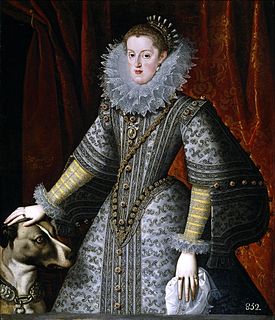
Bartolomé González y Serrano, (1564-1627) was a Spanish Baroque painter, specializing in painting portraits, which is shown as a continuation of Renaissance court portraits type practiced by Alonso Sánchez Coello and especially by Juan Pantoja de la Cruz.

Andrés López Polanco, was a Spanish Baroque painter specializing in portraits. Documented in Madrid between 1608 and 1641, he worked for the court of King Philip III of Spain and King Philip IV of Spain. His exact date of birth is unknown.

Antonio de Puga, was a Spanish Baroque painter.






















